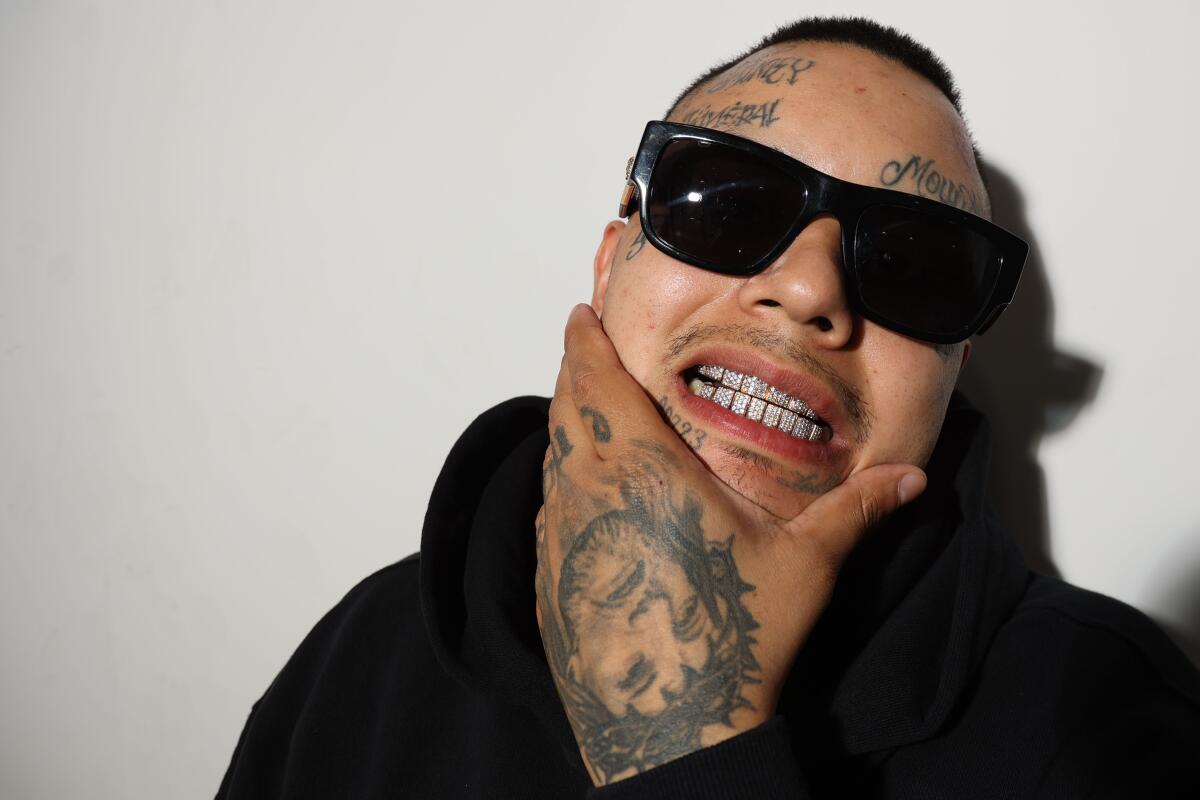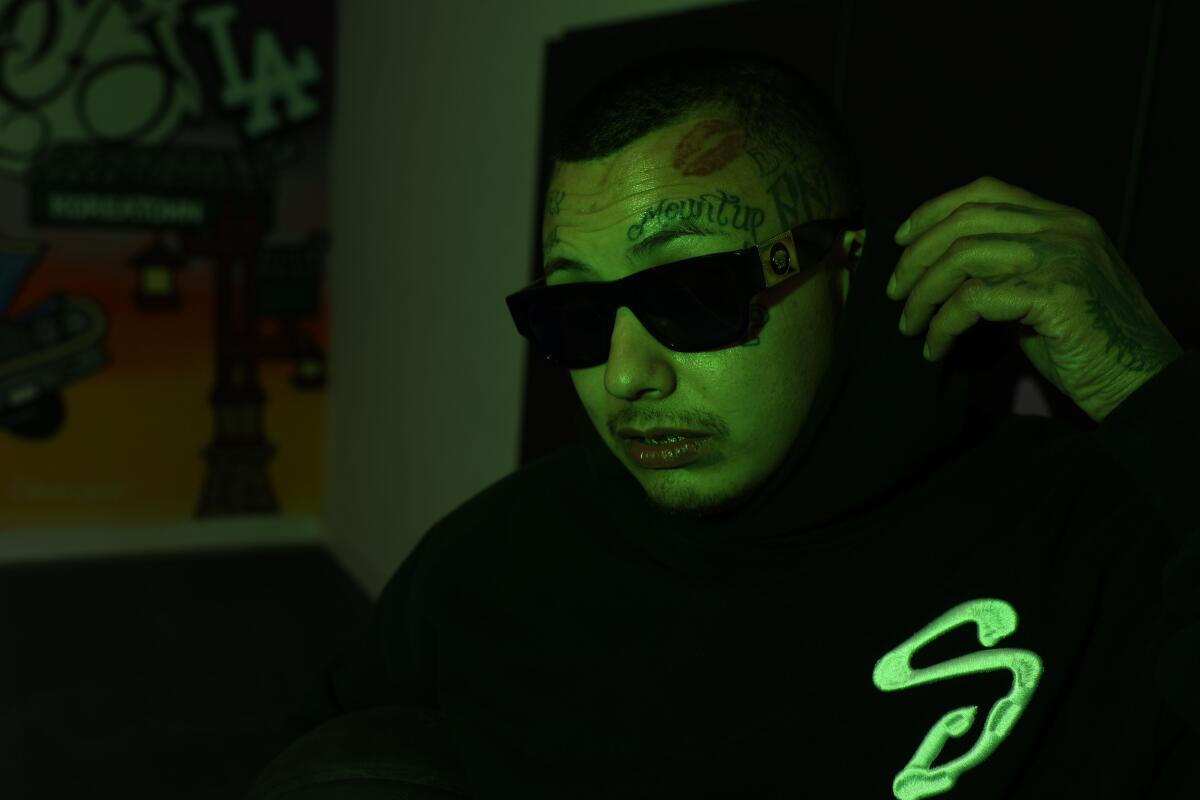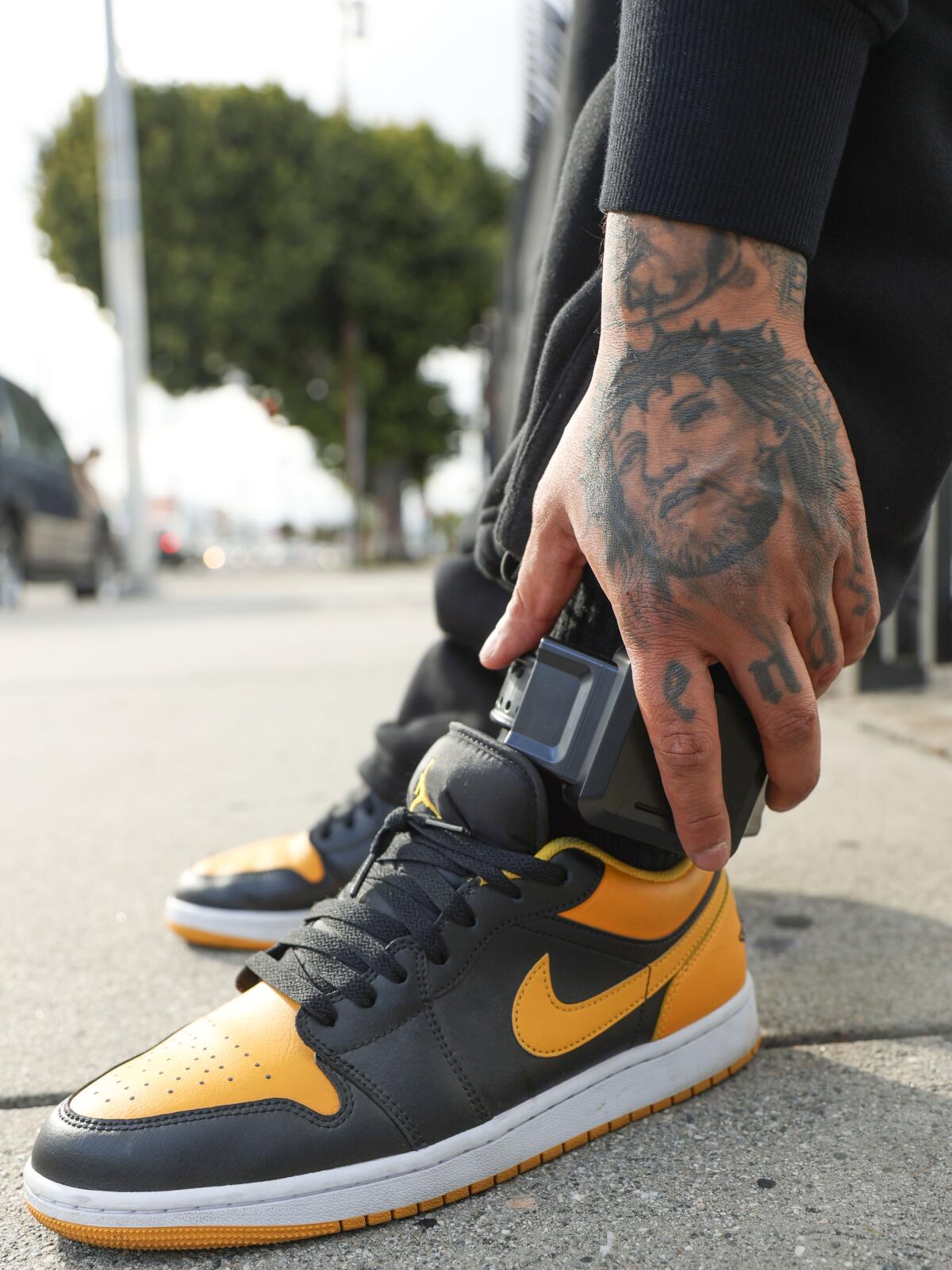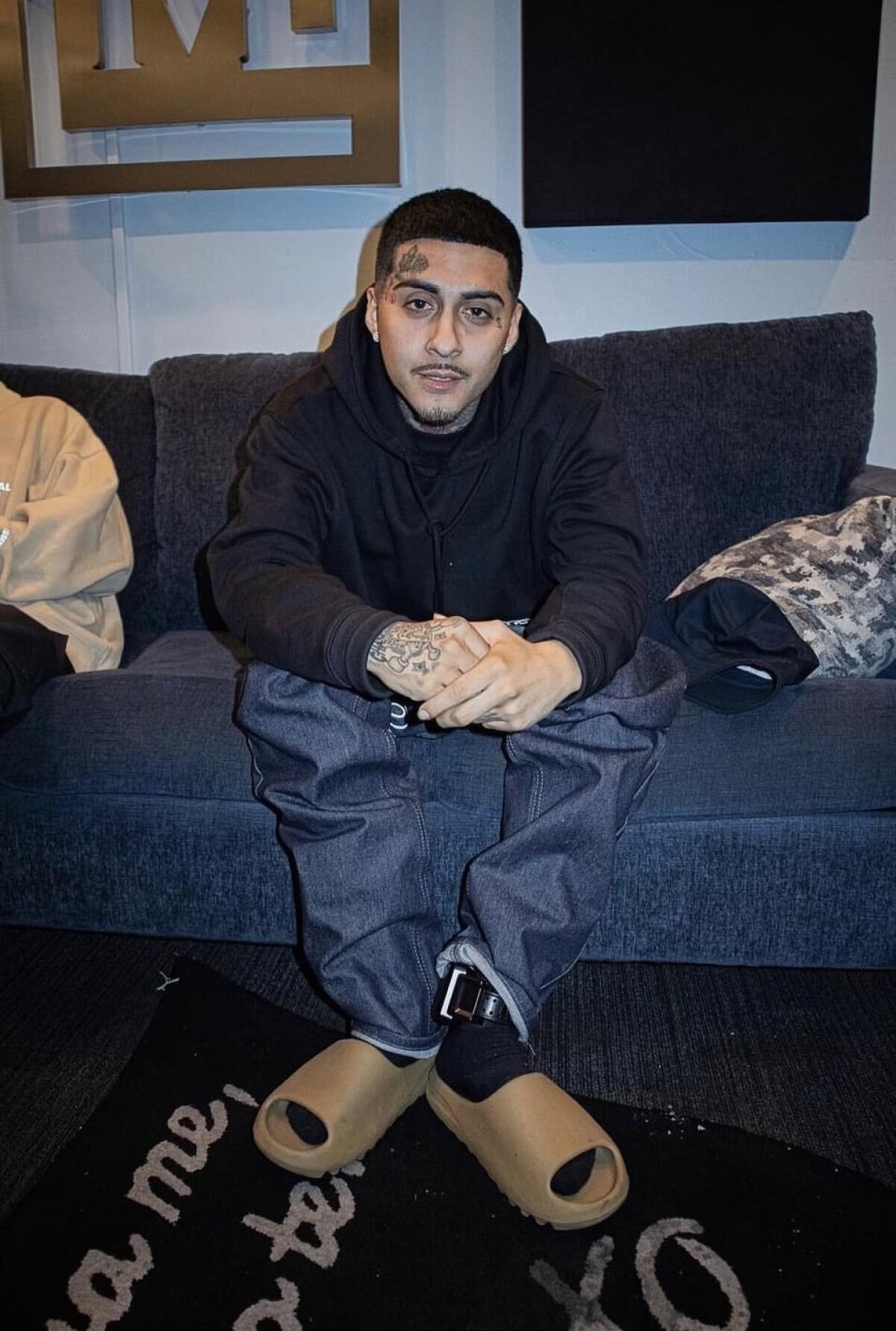Swifty Blue raps about L.A. gang life — and finds himself dodging real-life violence

- Share via
Everything about Nelson Abrego calls out for attention.
The tattoos that cover his face. The grills clamped to his teeth. The videos he posts on a constant basis, calling out anyone whose name might draw more eyes to his burgeoning career as the gangster rapper called Swifty Blue.
The strategy has paid off to a degree, bringing him millions of streams on Spotify, a collaboration with the rap star Kodak Black and a following on social media.
It has also drawn the ire of the Mexican Mafia.
A member of the prison-based syndicate, which holds sway over Latino street gangs and in lockups across the state, was recorded discussing an extortion attempt targeting Abrego, according to a tape reviewed by The Times. And in November, according to a law enforcement source who wasn’t authorized to speak publicly, Abrego was beaten and stabbed in the Los Angeles County jail by inmates suspected of acting on orders from the Mexican Mafia.
After this article was published, Abrego reiterated that he would not discuss any organized crime groups, to which he denied having any affiliation, and said he wished The Times would focus on his music.
Abrego’s collision with the Mexican Mafia underscores the uncomfortable and often unspoken relationship between Latino artists who rap about criminal activities and men who actually direct them. The Mexican Mafia’s 140 or so members control the landscape that serves as both an incubator for new rappers and inspiration for their music.

A Mexican Mafia member wouldn’t hesitate to “tax” a rapper any more than he would a drug dealer operating within his territory, said Leo Duarte, a retired state prison official who investigated the prison gang for decades. And most Latino rappers, Duarte added, are products of a gang subculture that teaches them to respect and fear “La Eme,” as the organization is known.
The assault on Abrego was not without precedent. MoneySign Suede, a young rapper from Huntington Park, was stabbed to death in a California prison last summer. Blackie Fontana, who had family ties to a Mexican Mafia member, was gunned down in a still-unsolved double homicide in 2017.
In an interview with The Times, Abrego refused to discuss the Mexican Mafia or any injuries suffered behind bars. “I really can’t speak on it,” he said, “because it’s like jailhouse politics.”
Wearing black and gold Versace sunglasses and a GPS ankle monitor above his black and yellow Jordans, Abrego spoke between sips from a smoothie and hits of cannabis wax from a glass pipe. He paused during the interview outside a Starbucks to take photographs with fans, telling one that The Times reporter was his probation officer.
Abrego, 28, is a proud to have grown up in Paramount, a city in southeast Los Angeles County where 80% of its 53,000 residents are Latino. The child of Salvadoran immigrants, Abrego said his father worked as a carpenter and his mother as a housekeeper.

At 15, Abrego followed an older brother into the Eastside Paramount gang. Among his many tattoos is an “ES” next to his right eye and a “P” beside the left.
In the 10th grade, Abrego was kicked out of Paramount High School for smoking marijuana and what he generally described as “gang-banging.” He knew by then he wanted to be a rapper, he said, having grown up admiring independent Los Angeles artists, including Nipsey Hussle and Mozzy.
Abrego released his first album, “Grimey Gang,” in 2019. His music, he said, reflects “what it’s like to be a real-life gangster.”
The lyrics are standard fare: His cars are fast, his drugs plentiful, his watches expensive and his women, too many to count. “Hear some gangster tales and some stories, some real life situations. Some real street stuff — not no Hollywood,” as he puts it.
What won Abrego a following were videos in which he held himself out as an ambassador of the Southern California underworld evoked in his music. In one video, he told outsiders they needed to “check in” before operating on his turf.
“If you out here in Los Angeles and you handling business, make sure you tap in with some solid homies for your own security,” he said in the video, flashing a gun. “Streets is dangerous. If you are not tapped in, you will get stepped on.”

Authorities have used some rappers’ own words to charge them with crimes, including the Atlanta-based superstar Young Thug, who is now standing trial on racketeering charges based in part on accounts of violence and drug dealing in his own songs. Young Thug and others have maintained their music is protected by freedom of expression — an art form, not a self-indictment.
Abrego told The Times he is a showman performing for an audience that wants more than just music. “What I’m selling people is the image,” he said. “Everybody wants to be a gangster. Whether you’re a lawyer, a police or a kid going to school, everybody wants to be big, bad and tough.”
He acknowledged many of his disputes with other rappers are staged. “Social media is my theater,” he said. “It’s Shakespeare. It’s acts, it’s skits. People are entertained by it.”
Not everybody.
In 2022, a Mexican Mafia member said in a recorded jail call that another unnamed member of the organization was demanding money from the rapper for “disrespecting” him, according to a tape reviewed by The Times. After publication, Abrego said he had no knowledge of the call and only learned of it when he read the article.
Asked how Latino rappers affiliated with gangs that are subservient to the Mexican Mafia navigate the dynamic, Abrego chose his words carefully. “It’s hard for you to be an independent Southern [California] rapper,” he said, “because you got to deal with the gang politics. That means there’s rules and regulations you have to follow. From the jail to the streets.”
The Mexican Mafia’s ties to the rap industry go back decades, said Duarte, the retired prisons official. In the early 2000s, rappers affiliated with the Eastside Trece gang caught the attention of authorities investigating Stacy Barajas, described by federal prosecutors in a forfeiture complaint as having paid two members of the Mexican Mafia to protect her drug business.
Rooted in South Los Angeles, Eastside Trece produced two of the three founding members of Brownside, the most popular Latino rap group of the 1990s. The gang followed the eastward exodus of families relocating from urban cores to the Inland Empire, creating a “clique,” or subset, in San Bernardino.
Barajas opened a studio in San Bernardino where the Eastside Trece rappers produced their records, according to an organized crime figure who knew Barajas and requested anonymity for fear of retaliation. The studio was shut down when Barajas was sent to prison in 2009 after admitting she solicited a Mexican Mafia member to kill a man.
Another rapper with underworld ties was gunned down in 2017. Roberto Diaz, who performed as Blackie Fontana, was the nephew of a Mexican Mafia member, according to testimony at the trial of an attorney charged with helping the organization.
The lawyer, Gabriel Zendejas Chavez, testified he met Diaz through another man, Arthur “Happy” Romero. Diaz and Romero were part of a group dubbed “the legal team” that associated with Chavez and his clients.
One night in 2017, sheriff’s deputies were called to a shooting on Elizondo Street in La Puente. They found Diaz, 32, lying face-up in a driveway with four bullets in his head, a coroner’s report shows. Romero, 51, was shot through the back. Their killings remain unsolved.

Last April, MoneySign Suede was found dead in the showers at the Correctional Training Facility in Soledad. The 22-year-old Huntington Park rapper — whose real name was Jaime Brugada Valdez — had been serving a 32-month sentence for possessing firearms when he was killed at the Monterey County prison.
Interviewing Brugada Valdez less than a year before his death, the podcast host known as “Adam22” remarked that a top manager refused to sign a Latino rapper because of the “politics” involved.
“Smart man,” Brugada Valdez said.
Abrego said he considered Brugada Valdez a friend, collaborating with him on songs and supporting his young career. Even though Brugada Valdez was not a gang member, Abrego said as a Latino, “there’s rules we got to follow, simple as that.” He declined to elaborate.
In November, sheriff’s deputies arrested Abrego on suspicion of possessing a gun as a felon, booking records show. Held in the Los Angeles County jail, Abrego was beaten and stabbed by other inmates, a law enforcement source said. The attack remains under investigation, but the source said authorities had reason to believe it was ordered by the Mexican Mafia.
Abrego wouldn’t talk about the organization. “I’m not trying to throw rocks,” he said. “I’m just trying to do my thing, my entrepreneurship.”
While being photographed by The Times inside the headquarters of Shaka Wear, a clothing brand that he supports, Abrego said people who follow him on social media should remember “the internet’s the internet.”
“Always take that into mind and consideration, you feel me?” he said. “Cause you might see me up in the streets and we might have a real interaction.”

What happened minutes later made clear, however, that some people take Abrego’s online persona seriously. As he was being photographed outside the clothing company, a car pulled up to the curb.
A man stepped out in a soiled T-shirt and work boots. He challenged Abrego, telling him to “get the f— out of here.”
“Ain’t nobody running,” Abrego said. He told the man he’d follow him somewhere they could “handle it.”
The man got in his car. Abrego followed in his black sedan.
More to Read
Sign up for This Evening's Big Stories
Catch up on the day with the 7 biggest L.A. Times stories in your inbox every weekday evening.
You may occasionally receive promotional content from the Los Angeles Times.













